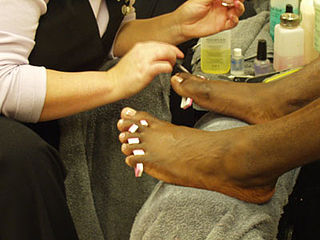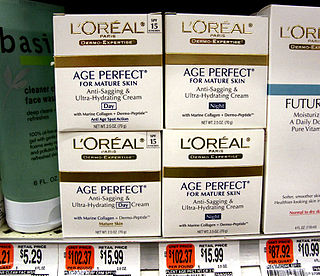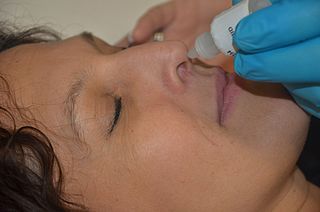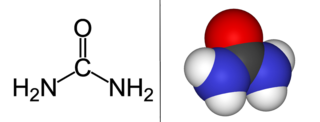Skin cream may refer to:
- Cream (pharmacy), a preparation usually for application to the skin
- Moisturizer, a cosmetic preparation used for protecting, moisturizing, and lubricating the skin
Skin cream may refer to:
Preparation H is an American brand of medications that is made by Pfizer, used in the treatment of hemorrhoids. Hemorrhoids are caused at least in part by inflamed blood vessels, and most versions of Preparation H work by reducing inflammation in blood vessels.

A pedicure is a cosmetic treatment of the feet and toenails, analogous to a manicure.

A facial is a family of skin care treatments for the face, including steam, exfoliation, extraction, creams, lotions, facial masks, peels, and massage. They are normally performed in beauty salons, but are also a common spa treatment. They are used for general skin health as well as for specific skin conditions. Types of facials include European facial, LED light therapy facials, hydrafacials and mini-facials.

Anti-aging creams are predominantly moisturizer-based skin care products marketed with unproven claims of making the consumer look younger by reducing, masking or preventing signs of skin aging. Anti-aging supplements are ingestible products promoted to diminish the effects of aging, including vitamin supplements, powders, and teas.

A topical medication is a medication that is applied to a particular place on or in the body. Most often topical medication means application to body surfaces such as the skin or mucous membranes to treat ailments via a large range of classes including creams, foams, gels, lotions, and ointments. Many topical medications are epicutaneous, meaning that they are applied directly to the skin. Topical medications may also be inhalational, such as asthma medications, or applied to the surface of tissues other than the skin, such as eye drops applied to the conjunctiva, or ear drops placed in the ear, or medications applied to the surface of a tooth. The word topical derives from Greek τοπικόςtopikos, "of a place".

A moisturizer, or emollient, is a cosmetic preparation used for protecting, moisturizing, and lubricating the skin. These functions are normally performed by sebum produced by healthy skin. The word "emollient" is derived from the Latin verb mollire, to soften.

Cold cream is an emulsion of water and certain fats, usually including beeswax and various scent agents, designed to smooth skin and remove makeup. Cold cream is a water-in-oil emulsion, unlike the oil in water emulsion of vanishing cream, so-called because it seems to disappear when applied on skin. The name "cold cream" derives from the cooling feeling that the cream leaves on the skin. Variations of the product have been used for nearly 2000 years.

Xeroderma, xerosis or xerosis cutis, or simply dry skin, is a skin condition characterized by excessively dry skin.

Aftershave is a product applied to skin after shaving. Traditionally, it is an alcohol-based liquid (splash), but it can be a lotion, gel, or even a paste.

Cetaphil or is a line of skin care products from the Swiss company Galderma, including cleansers, bar soap, cream, lotion, and moisturizers. It was developed in 1947, in Texas, by an American pharmacist. Cetaphil products are available worldwide in more than 70 countries, commonly sold at grocery stores and pharmacies throughout the United States, Canada, India and Nepal. They are also available in pharmacies in Australia, Hong Kong, South Korea, Indonesia, the Philippines, South Africa, Singapore, some European, Latin American and Caribbean countries.

Lotion is a low-viscosity topical preparation intended for application to the skin. By contrast, creams and gels have higher viscosity, typically due to lower water content. Lotions are applied to external skin with bare hands, a brush, a clean cloth, or cotton wool.
Skin care or skincare is a range of practices that support skin integrity, enhance its appearance, and relieve skin conditions. They can include nutrition, avoidance of excessive sun exposure, and appropriate use of emollients. Practices that enhance appearance include the use of cosmetics, botulinum, exfoliation, fillers, laser resurfacing, microdermabrasion, peels, retinol therapy, and ultrasonic skin treatment. Skin care is a routine daily procedure in many settings, such as skin that is either too dry or too moist, and prevention of dermatitis and prevention of skin injuries.

Aqueous Cream BP, also known as sorbolene, is a light, hydrocarbon-based emulsion, which is officially registered in the British Pharmacopoeia and categorised by the British National Formulary as a non-proprietary emollient preparation. It is used as a topical, external medicine, emollient moisturiser, and general-purpose substitute for toiletries such as soap, shower gel, shaving cream, and lip salve.
Personal care products are consumer products which are applied on various external parts of the body such as skin, hair, nails, lips, external genital and anal areas, as well as teeth and mucous membrane of the oral cavity, in order to make them clean, protect them from harmful germs and keep them in good condition. They promote personal hygiene and overall health, well-being and appearance of those body parts. Toiletries form a narrower category of personal care products which are used for basic hygiene and cleanliness as a part of a daily routine. Cosmetic products, in contrast, are used for personal grooming and beautification. Pharmaceutical products are not considered personal care products.
Eyelid dermatitis is commonly related to atopic dermatitis or allergic contact dermatitis. Volatile substances, tosylamide, epoxy hardeners, insect sprays, and lemon peel oil may be implicated, with many cases of eyelid contact dermatitis being caused by substances transferred by the hands to the eyelids.
A barrier cream is a topical formulation used in industrial applications and as a cosmetic to place a physical barrier between the skin and contaminants that may irritate the skin. There are many other terms for creams designed to protect skin from harmful substances, including skin protective creams, pre-work creams, antisolvent gels, protective ointments, and shielding lotions. Three classes of barrier creams are used: water repellent creams, water-soluble creams, and creams designed for special applications. Barrier creams may contain substances such as zinc oxide, talc or kaolin to layer over the skin. For hand care they are designed to protect against the harm from detergents and other irritants.

BB cream is a marketing term that stands for blemish balm, blemish base, beblesh balm, and in Western markets, beauty balm. Products marketed as BB creams are generally designed to serve as a foundation, moisturizer, and sunscreen all at once.

Urea, also known as carbamide-containing cream, is used as a medication and applied to the skin to treat dryness and itching such as may occur in psoriasis, dermatitis, or ichthyosis. It may also be used to soften nails.

CC cream is a marketing term coined in the wake of the marketing term Blemish Balm cream or Beauty Balm. "CC cream" is used by some brands to mean Color Control cream, or Color Correcting cream, and some brands claim to reduce the appearance of skin redness or sallowness or to improve uneven skin tone. BB creams and CC creams are both tinted moisturizers containing sun protection. There is no scientific definition for either term, nor is there quantifiable basis for difference between BB creams and CC creams: differences between the two vary from brand to brand. BB cream was originally formulated in Germany and has, in recent years, gained popularity in Asia, especially South Korea, and is also gaining popularity in Europe and North America.
DD cream is a marketing term that followed the invention of BB creams and CC creams, and it often stands for dynamic do-all or daily defense. There is no quantifiable definition of a DD cream that distinguishes it from BB or CC creams.